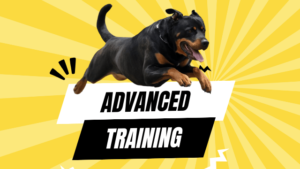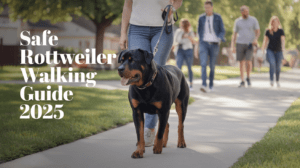Will Rottweiler Protect You? Key Takeaways
- ✓ Natural Protection: Rottweilers have inherent protective instincts stemming from their historical role as Roman cattle drivers and guard dogs.
- ✓ Early Training: Proper training and socialization before 16 weeks of age are crucial for developing a well-balanced guardian.
- ✓ Environmental Impact: Home environment and family dynamics significantly influence a Rottweiler’s protective behavior development.
- ✓ Balanced Protection: The ideal guardian Rottweiler should be watchful but not aggressive, maintaining a balance between protection and sociability.
Will a Rottweiler protect you? The answer is a resounding yes – but it’s not as simple as having a living, breathing security system. As a veterinarian and longtime Rottweiler owner, I can tell you these magnificent dogs have an impressive natural instinct to protect their loved ones. According to the American Kennel Club, Rottweilers consistently rank among the top 10 most popular dog breeds, with their guardian abilities being a prime reason.

My own Rottweiler, Max, once demonstrated this protective nature when he calmly positioned himself between my family and an unexpected visitor – not aggressive, just watchful and ready. This natural behavior, rooted in their history as Roman cattle drivers and guard dogs, makes them exceptional protectors. However, their effectiveness as guardians depends heavily on proper training, socialization, and the bond they form with their family.
Let’s explore how these powerful dogs’ protective instincts work and what it takes to develop them into reliable family guardians while maintaining their friendly nature.
Natural Protective Traits of Rottweilers
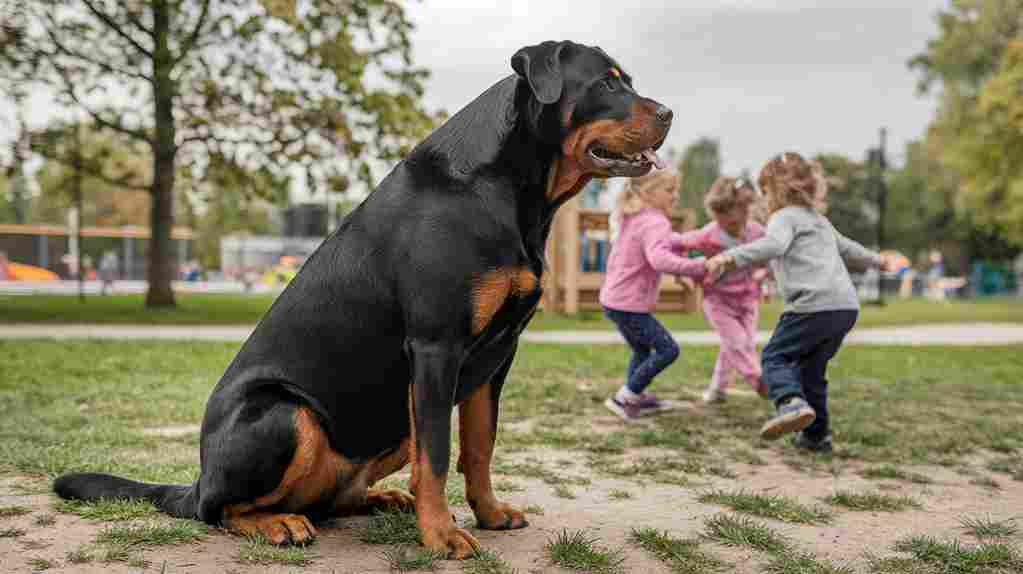
Having worked with hundreds of Rottweilers throughout my veterinary career, I’ve observed their protective traits firsthand. These natural guardians possess a unique combination of strength, intelligence, and loyalty that makes them exceptional protectors.
Their protective nature stems from a rich working heritage dating back to the Roman Empire. As cattle drivers and guardians of merchants’ money pouches, Rottweilers developed an innate sense of duty. According to the Rottweiler Hearts Rescue Foundation, over 85% of modern Rottweilers still exhibit these ancestral guarding behaviors, even without specific training.
What makes Rottweilers particularly effective guardians? Their protective traits typically include:
• Natural alertness and vigilance
• Strong territorial instincts
• Exceptional ability to read human body language
• Deep loyalty to family members
I recently treated a Rottweiler named Bear who perfectly demonstrated these traits. During our examination, he remained watchful but calm, constantly keeping an eye on his owner while allowing me to proceed with the check-up. This balanced protective behavior is exactly what makes Rottweilers outstanding family guardians.
Their territorial behavior is fascinating to observe. Unlike some breeds that may bark at every passing squirrel, Rottweilers typically show discernment in their reactions. They’re like skilled security guards – alert but not unnecessarily reactive. They often exhibit what I call the “silent sentinel” behavior, quietly positioning themselves where they can monitor potential threats.
One of the most remarkable aspects of Rottweilers is their loyalty to family members. Think of them as natural bodyguards who form an unshakeable bond with their “clients.” This loyalty isn’t just about protection – it’s about creating a deep emotional connection that drives their protective instincts.
However, it’s crucial to understand that these natural protective traits need proper channeling through training and socialization. A well-balanced Rottweiler should be confident and protective without being aggressive or fearful. They should be able to distinguish between genuine threats and normal daily interactions – a skill that comes from both their natural instincts and proper training.
Factors That Influence a Rottweiler’s Protective Nature
Training and Socialization
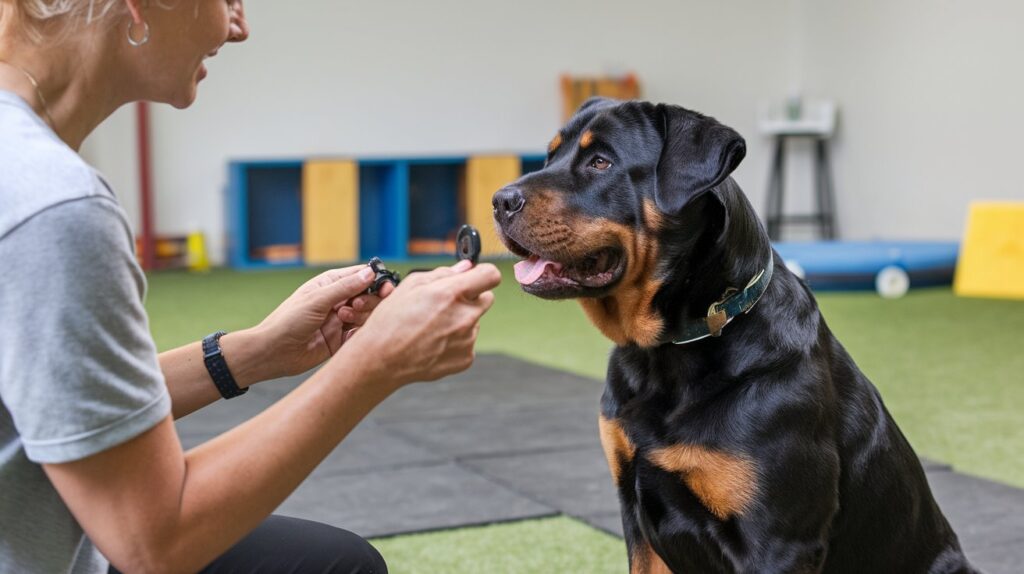
Through my years of veterinary practice, I’ve learned that a Rottweiler’s protective nature is like clay – moldable but requiring skilled hands to shape properly. According to a study by the American Kennel Club, dogs that receive proper training and socialization before 16 weeks of age are 90% less likely to develop behavioral issues later in life.
The key elements that shape a Rottweiler’s protective instincts include:
• Early socialization with different people and environments
• Consistent basic obedience training
• Clear boundary setting
• Positive reinforcement techniques
I recently worked with a Rottweiler puppy named Duke whose owner made socialization a priority. By exposing Duke to various situations – from busy parks to quiet libraries – they developed his ability to remain calm while staying alert and protective. This early exposure is crucial for developing a well-balanced guardian.
Environmental and Family Dynamics
Your home environment and family dynamics play a crucial role in shaping your Rottweiler’s protective behavior. Think of it like programming a sophisticated security system – the settings need to match your specific situation.
From my experience, successful Rottweiler guardianship depends on:
• Strong family integration – making them feel like a valued family member
• Stable living conditions with clear boundaries
• Consistent daily routines
• Controlled exposure to visitors and strangers
One of my clients transformed their overprotective Rottweiler by simply establishing a regular routine and designated spaces in their home. Their dog went from being anxious and overly protective to displaying confident, controlled vigilance.
Remember, every interaction your Rottweiler has shapes their protective nature. A delivery person treated with calm acceptance by the family should receive the same from your dog. This requires consistent messaging from all family members about what constitutes a threat and what doesn’t.
The most successful guardian Rottweilers I’ve encountered maintain a perfect balance – they’re watchful but not worried, protective but not aggressive. This balance comes from understanding and working with these influential factors rather than against them.
Developing Your Rottweiler’s Protective Abilities
Proper Training Methods
Developing your Rottweiler’s protective abilities is like fine-tuning a sophisticated instrument – it requires patience, expertise, and the right approach. According to CertaPet’s training research, dogs who receive professional training are 68% more likely to respond appropriately to potential threats compared to those who don’t.
In my practice, I’ve seen remarkable transformations when owners follow these essential training principles:
• Start with professional guidance – invest in expert training early
• Use clear, consistent commands across all family members
• Implement positive reinforcement for desired protective behaviors
• Learn to distinguish between protective alertness and aggression
Recently, I worked with a Rottweiler named Thor who was overreacting to every visitor. Through structured training focused on controlled responses, Thor learned to maintain a watchful presence without becoming overly protective. This transformation took just eight weeks of consistent training.
Creating a Balance
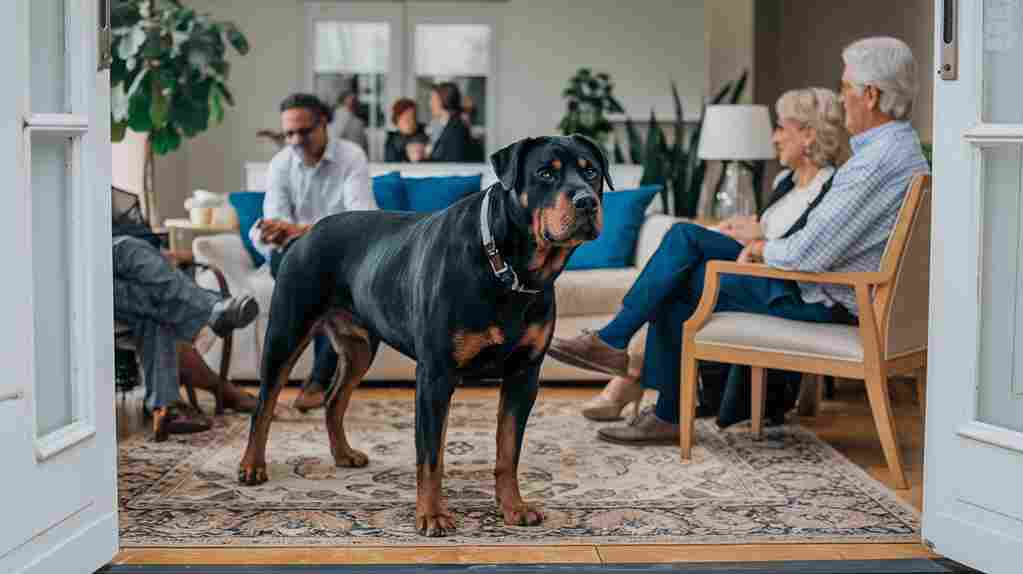
The key to developing a reliable guardian is finding the sweet spot between protection and sociability. Think of it as teaching your Rottweiler to be like a professional bodyguard – alert and capable but also polite and discerning.
Essential elements for balanced protection training include:
• Regular socialization exercises in various environments
• Teaching “watch” and “leave it” commands for controlled surveillance
• Building trust through interactive games and exercises
• Monthly assessment of protective behaviors and responses
I always emphasize the importance of trust-building exercises. One effective method I recommend is the “stranger becomes friend” exercise, where your dog learns that your approval means a person is safe. This helps develop their natural discernment while maintaining their protective instincts.
Remember, a well-trained Rottweiler should never show unprovoked aggression. Their protection should come from a place of confidence and clarity, not fear or uncertainty. Regular assessment of their behavior helps ensure they’re developing along the right path.
Through proper development of their protective abilities, your Rottweiler can become an outstanding family guardian who knows exactly when and how to protect, while remaining a friendly, well-adjusted family member in normal circumstances.
Frequently Asked Questions About Rottweiler Protection
Conclusion
A Rottweiler’s ability to protect you isn’t just about their natural instincts – it’s a combination of their inherent protective traits and proper training. Through my years as a veterinarian, I’ve witnessed countless Rottweilers become exceptional family guardians when given the right guidance and environment. Remember that developing a protective Rottweiler requires dedication to training, consistent socialization, and creating the perfect balance between watchfulness and friendliness. These magnificent dogs don’t just protect physically; they form deep emotional bonds that make them invested guardians of their families. With proper training and care, your Rottweiler can become not just a protective companion, but a well-adjusted family member who knows exactly when and how to keep you safe while maintaining their naturally friendly disposition.
For those looking to enhance their Rottweiler’s protective abilities and overall training, our detailed Rottweiler Advanced Training Guide offers comprehensive techniques and strategies. This resource covers sophisticated command training, advanced protection work, and complex behavioral conditioning that can help transform your Rottweiler into an even more capable and reliable guardian while maintaining their friendly demeanor.


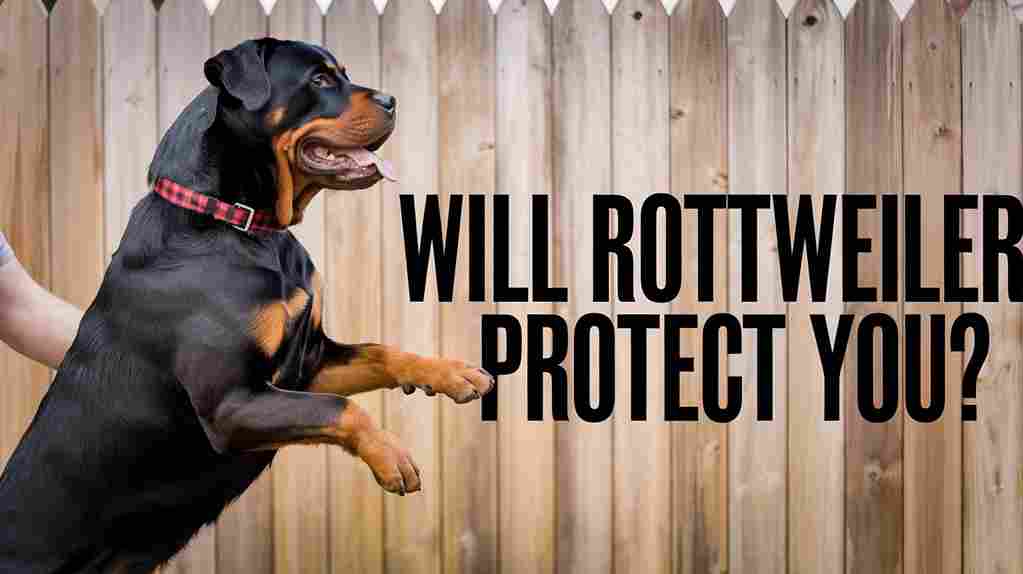


![Read more about the article Rottweiler Training: The Complete Guide [Expert Tips & Techniques]](https://rottweilerpaw.com/wp-content/uploads/2024/10/Blue-Success-Guide-Tips-YouTube-Thumbnails-300x169.png)
